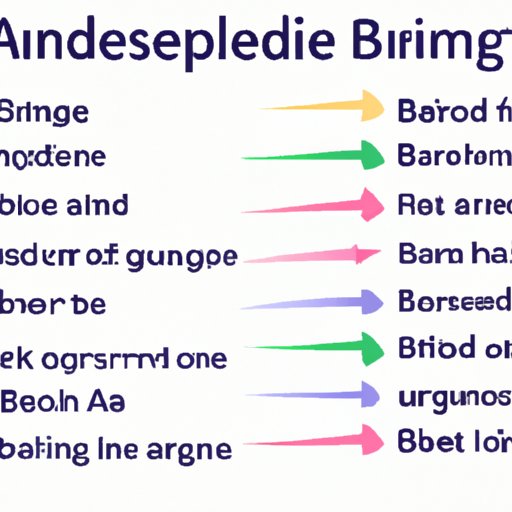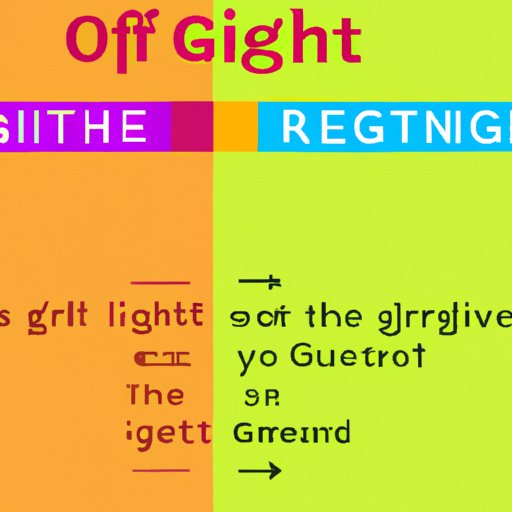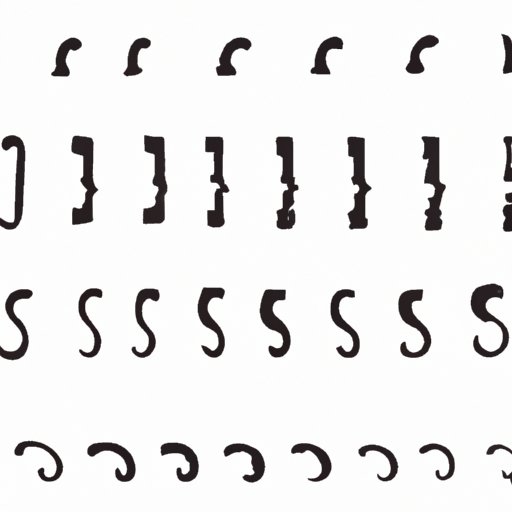Introduction
Brackets are a type of punctuation used in writing to indicate a range of things, from clarifying information to separating elements within a sentence. They are often misused or misunderstood, so it’s important to understand what brackets are for in writing and how to use them correctly. This article will explore the basics of brackets, provide a comprehensive guide to using them in writing, and offer tips for mastering the art of using brackets in your writing.
Exploring the Basics of Brackets: What Are They and How Do You Use Them?
Brackets are symbols that can be used in writing to enclose words, phrases, or even whole sentences. They are generally used to clarify or emphasize a point, or to separate elements within a sentence. There are three main types of brackets: parentheses, square brackets, and curly brackets. Let’s take a look at each type and how they can be used.
Definition of Brackets
The term “bracket” is used to describe any symbol that is used to group words, phrases, or sentences together. The most commonly used brackets are parentheses ( ), square brackets [ ], and curly brackets { }. Each of these has its own purpose and function, which you’ll learn more about later.
Different Types of Brackets
As mentioned above, there are three main types of brackets: parentheses, square brackets, and curly brackets. Each type serves a specific purpose and should be used accordingly. Let’s take a closer look at each type.
Parentheses
Parentheses ( ) are the most commonly used type of bracket. They are used to set off additional information within a sentence, such as an afterthought, explanation, or comment. They can also be used to separate items in a list or to cite sources.
Square Brackets
Square brackets [ ] are used to add information to a sentence that was not originally part of the sentence. This could be anything from an editor’s notes to a reference to another source. Square brackets are also used to indicate that a word or phrase has been replaced by something else in a quotation.
Curly Brackets
Curly brackets { } are used to group words, phrases, or clauses together. They are also commonly used to indicate a repetition in a pattern, such as in mathematical equations or musical notation.
Examples of How to Use Brackets
Now that you know what each type of bracket is used for, let’s take a look at some examples of how to use them in writing.
- Parentheses: She always brings her laptop (even when she doesn’t need it).
- Square brackets: He [John] was the only one who spoke up.
- Curly brackets: The students {George, Sarah, and Mary} all passed the exam.

A Comprehensive Guide to Using Brackets in Writing
Now that you have a better understanding of what brackets are and how they can be used, let’s take a look at some rules for using them correctly in writing.
Rules for Using Parentheses
- Do not use parentheses to set off a complete sentence.
- Do not use parentheses to set off a phrase that is essential to the meaning of the sentence.
- Do not use parentheses to set off a phrase that forms part of a complete sentence.
- Do not use parentheses to set off a phrase that is already set off with commas or other punctuation marks.
Rules for Using Square Brackets
- Do not use square brackets to set off a complete sentence.
- Do not use square brackets to set off a phrase that is essential to the meaning of the sentence.
- Do not use square brackets to set off a phrase that forms part of a complete sentence.
- Do not use square brackets to set off a phrase that is already set off with commas or other punctuation marks.
Rules for Using Curly Brackets
- Do not use curly brackets to set off a complete sentence.
- Do not use curly brackets to set off a phrase that is essential to the meaning of the sentence.
- Do not use curly brackets to set off a phrase that forms part of a complete sentence.
- Do not use curly brackets to set off a phrase that is already set off with commas or other punctuation marks.
A Beginner’s Guide to Understanding Brackets in Writing
Now that you’re familiar with the rules for using brackets, let’s take a look at some common mistakes people make when using them and some tips for using them correctly.
Common Mistakes When Using Brackets
- Using brackets incorrectly. Make sure you understand the rules for using each type of bracket before using them in your writing.
- Misusing parentheses. Parentheses are not interchangeable with commas or other punctuation marks. Make sure you use them only for their intended purpose.
- Misplacing brackets. Make sure to place brackets in the correct spot within a sentence. They should never be placed at the beginning or end of a sentence.
Tips for Using Brackets Correctly
- Read over your writing carefully to make sure you’ve used brackets correctly.
- Make sure you understand the purpose and function of each type of bracket before using them.
- Pay attention to proper punctuation when using brackets.
- If in doubt, leave out the brackets. It’s better to be safe than sorry.
Making Sense of Brackets: A Step-by-Step Guide
Now that you know the basics of brackets and how to avoid common mistakes, let’s take a look at how to incorporate them into your writing for maximum effect.
Identifying When to Use Brackets
The first step to using brackets correctly is knowing when to use them. Generally speaking, brackets should only be used when absolutely necessary. If you’re unsure whether or not to use them, ask yourself if the information enclosed within the brackets is essential to the meaning of the sentence. If not, then it’s better to leave it out.
Knowing the Purpose and Function of Each Type of Bracket
As mentioned before, each type of bracket has its own purpose and function. Make sure you understand the difference between each type before using them in your writing. This will help ensure that you’re using them correctly and effectively.
Placing and Formatting Brackets Within a Sentence
Once you’ve identified when and how to use brackets, it’s important to pay attention to how they’re placed and formatted within a sentence. Brackets should always be placed outside of any punctuation marks, such as commas or periods. They should also be placed in the same font and size as the rest of the text and should not be bolded or italicized.

How to Incorporate Brackets in Your Writing for Maximum Effect
Now that you know how to properly use brackets, let’s take a look at how to use them for maximum effect.
Examples of How to Use Brackets to Emphasize Points
Brackets can be used to emphasize points in a sentence. For example, if you want to emphasize a particular word or phrase, you can enclose it within brackets. This can be especially useful when making a point or drawing attention to something important.
Strategies for Incorporating Brackets Into Longer Pieces of Writing
When writing longer pieces of writing, such as essays or articles, it’s important to use brackets sparingly. Overusing brackets can make your writing cluttered and hard to read. Instead, focus on using them only when absolutely necessary to emphasize or clarify a point. This will help ensure that your writing flows naturally and is easy to read.
The Art of Using Brackets: Mastering the Rules of Punctuation
Punctuation is an essential part of effective writing, and brackets are no exception. Here are some guidelines for proper punctuation when using brackets.
Guidelines for Proper Punctuation
- When using parentheses, the punctuation mark should always be placed outside the parentheses.
- When using square brackets, the punctuation mark should always be placed inside the brackets.
- When using curly brackets, the punctuation mark should always be placed outside the brackets.

Get it Right: An Overview of Brackets in Grammar and Writing
Now that you have a better understanding of brackets and how to use them correctly, let’s take a look at some examples of incorrect usage and some common rules to remember when using brackets.
Examples of Incorrect Usage of Brackets
- Using brackets to set off a complete sentence.
- Using parentheses to set off a phrase that is essential to the meaning of the sentence.
- Using square brackets to set off a phrase that forms part of a complete sentence.
- Using curly brackets to set off a phrase that is already set off with commas or other punctuation marks.
Common Rules to Remember When Using Brackets
- Know when to use each type of bracket.
- Pay attention to proper punctuation when using brackets.
- Place brackets in the correct spot within a sentence.
- Use brackets sparingly and only when absolutely necessary.
Conclusion
Brackets are a powerful tool for emphasizing points and clarifying information in writing. However, it’s important to understand what brackets are for in writing and how to use them correctly. This article has explored the basics of brackets, provided a comprehensive guide to using them in writing, and offered tips for mastering the art of using brackets in your writing. By following the rules outlined here and paying attention to proper punctuation, you can use brackets to your advantage in your writing.
(Note: Is this article not meeting your expectations? Do you have knowledge or insights to share? Unlock new opportunities and expand your reach by joining our authors team. Click Registration to join us and share your expertise with our readers.)
